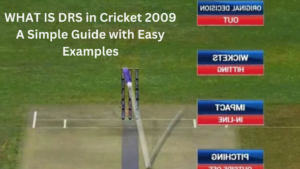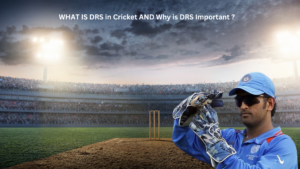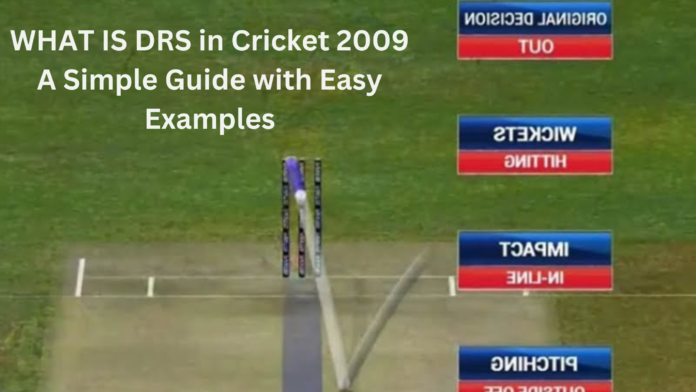WHAT IS DRS in Cricket 2009 A Simple Guide with Easy Examples
WHAT IS DRS ITS stands for Decision Review System. It’s a technology used in sports, mainly cricket, to help umpires make better decisions. It allows players and teams to challenge the on-field umpire’s decision, using technology like cameras, ball-tracking systems, and audio detection tools. It’s designed to reduce human error and ensure fair play. In this article, we’ll dive into how DRS works and explain it with simple examples so that you can understand it easily.

WHAT IS DRS in Cricket AND Why is DRS Important ?
In cricket, umpires make decisions based on what they see on the field. However, it’s easy for them to make mistakes because everything happens so fast. For example, they might not clearly see if the ball has hit the bat before hitting the pads, or whether a fielder caught the ball cleanly. DRS helps solve this problem by providing a second look with technology to confirm or overturn the umpire’s call.
Components of DRS – Decision Review System involves several tools and technologies to provide accurate results:
1. Hawk-Eye: This is a ball-tracking technology that shows the path of the ball. It’s used to check if the ball would have hit the stumps in LBW (Leg Before Wicket) decisions.
2. Ultra Edge or Snicko meter These tools use sound technology to detect if the ball has touched the bat. If there’s a small sound when the ball passes close to the bat, it indicates that the bat and ball made contact.
3. Hot Spot : This is a heat-sensing camera that shows if the ball hit the bat or pads by detecting the heat generated by the impact.
4. Slow-Motion Replays : High-speed cameras capture every moment in slow motion, allowing umpires to review catches or other critical moments.

How Does DRS ( Decision Review System ) Work ?
When a player disagrees with an umpire’s decision, they can request a DRS review. Here’s how it works step by step:
The Call : Suppose a batsman is given out for LBW, but he thinks he hit the ball with his bat first. The team can choose to use DRS to challenge the umpire’s call.
Third Umpire Review : Once DRS is requested, the third umpire checks the footage using tools like Hawk-Eye, Ultra Edge, and Hot Spot to review the incident.
Decision Confirmation : The third umpire looks at the evidence. If it shows the batsman did indeed hit the ball before it hit the pads, the decision will be reversed, and the batsman will be called “not out.”
Signal : The third umpire then communicates the decision back to the on-field umpire, who signals the final decision to the players and the crowd.
Example: LBW Decision Using DRS
Let’s say a bowler bowls a fast delivery, and it hits the batsman’s pads. The on-field umpire raises his finger, signaling that the batsman is out LBW. However, the batsman believes he hit the ball first with his bat before it touched his pads. The batsman’s team decides to challenge the decision using DRS.
The third umpire starts by using Ultra Edge to check if there’s any sound when the ball passes the bat. If there’s a spike on the graph, it means the bat made contact. Next, he uses Hawk-Eye to track the ball’s path and see if it was heading towards the stumps. After reviewing the evidence, the third umpire finds that the ball did hit the bat before hitting the pads, so he overturns the decision, and the batsman is declared “not out.”
Example: Caught Behind Decision Using DRS
Imagine a bowler bowls a delivery that slightly moves away from the batsman. The ball passes close to the edge of the bat, and the wicketkeeper catches it. The bowler and fielders appeal, and the umpire gives the batsman out for being caught behind. The batsman, who thinks he didn’t touch the ball, challenges the decision.
The third umpire uses Ultra Edge and checks the replay. If there is no sound or spike when the ball passes the bat, it shows that the ball didn’t touch the bat, and the umpire’s decision is reversed. The batsman remains not out.
Advantages of DRS Decision Review System
- Reduces Errors : DRS reduces the number of incorrect decisions, making the game fairer for both teams.
- Fair Play : It ensures that players get a second chance if they believe they have been wrongly judged.
- Transparency : Fans and players can see how decisions are made, which adds to the excitement of the game.
Challenges and Limitations of DRS
- Technology Dependence : DRS relies heavily on technology, and technical issues can cause delays or errors in decision-making.
- Human Judgment : While technology helps, the final decision still depends on the third umpire’s interpretation, which can sometimes be subjective.
- Availability : Not all cricket matches have access to DRS, especially in smaller or local games, due to the cost and availability of the technology.
DRS in Other Sports Decision Review System
While DRS is mainly used in cricket, similar systems are also used in other sports: Tennis Hawk-Eye technology is used to review line calls, allowing players to challenge if they think the ball was called incorrectly. Football (VAR): The Video Assistant Referee (VAR) reviews important decisions like goals, offsides, and fouls to assist the on-field referee.
DRS Rules in Cricket ( Decision Review System)
Each team is allowed a limited number of DRS reviews per innings, usually two. If the team challenges a decision and it’s successful (the umpire’s decision is overturned), they don’t lose a review. But if the decision stands, they lose one review. This rule ensures that teams use DRS carefully and not for every appeal.
WHAT IS DRS ( Decision Review System ) – How DRS Has Changed the Game
Since its introduction, DRS has had a significant impact on cricket:
– More Accurate Decisions**: Players trust that the system will help make the right call.
– Less Pressure on Umpires**: Umpires know that they have technology to support them, reducing the pressure to make perfect decisions on the spot.
Better Player Strategies: Teams now strategize on when to use DRS, saving their reviews for critical moments.
Think of DRS like a replay in a video game. If you feel like something went wrong or was unfair, you can press the replay button to see what happened in slow motion. In cricket, DRS acts like this replay button, letting players and umpires double-check decisions using technology.
Thanks And Regards




Nice content on DRS, Thanks for sharing
More Accurate Decisions**: Players trust that the system will help make the right call.